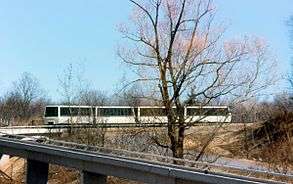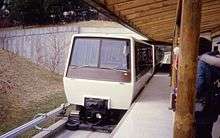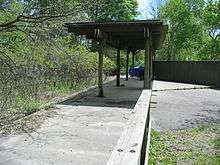Toronto Zoo Domain Ride
 | |
| Overview | |
|---|---|
| Locale | Toronto Zoo |
| Transit type | Automated guideway transit |
| Number of lines | 1 |
| Number of stations | 3 |
| Operation | |
| Began operation | 1976 |
| Ended operation | 1994 |
| Operator(s) | Metro Toronto Zoo |
| Technical | |
| System length | 5.6 kilometres (3.5 mi) |
| Metro Toronto Zoo Domain Ride | |
|---|---|
| Overview | |
| Status | Closed and partially dismantled |
| Locale | Scarborough, Ontario, Canada |
| Termini | Main Station |
| Stations | 3 (expanded to 5) |
| Services | 1 |
| Operation | |
| Opened | 1976 |
| Closed | 1994 |
| Owner | Metro Toronto Zoo |
| Operator(s) | Metro Toronto Zoo |
| Rolling stock | Bendix-Dashaveyor AGT |
| Technical | |
| Line length | 5.6 km (3.48 mi) |
| Highest elevation | Elevated |
The Toronto Zoo Domain Ride (also known as the Canadian Domain Ride) was an automated guideway transit (AGT) service used to carry visitors between sections, or "domains", of the Toronto Zoo. Though technologically closer to a simple rubber-tyred metro, it was almost universally referred to as a monorail.
The train began running in 1976, and closed in 1994, after a train lost power and rolled backwards down the track into a second train, injuring about 30 people. Parts of the line were subsequently taken over by the Zoomobile, an open-air tractor-drawn vehicle with five stations (Main Station, Canadian Domain Station, Africa Station, Americas Station)[1] which had been operating since 1980.[2]
Ride details

The vehicle was a rubber-wheeled AGT prototype[3] developed by American firm Bendix-Dashaveyor.[4] The train operated on a concrete guideway with electricity supplied by rails located above one side of the guideway. Passengers entered and left via doors located at each double row of facing seats. A secondary set of controls was available in the last car of the train to allow it to be reversed into the strorage/service area located towards the north end of the zoo property.

In addition to being a quick way to travel between sections of the zoo, the ride provided the only way to view several animals, in remote areas of the zoo. Moose, white-tailed deer and several other exhibits were not accessible from walking paths. The ride operator would provide commentary on the animals visible from the train during the ride.
Plans to scrap the vehicle and tracks dragged well past 1999. Portions of the guideway have now been removed, while others remain in place (overgrown by vegetation in many areas), but the electrical supply rails have been removed from the remaining portions of the guideway. Three stations remain in place: the Americas station stands behind closed gates, and the Weston station is still accessible for washrooms—the crumbling station platform can be seen from behind the chain barriers

The Main Station still remains to this day and is now used for several purposes: the Peacock Cafe, and the Main Zoomobile station.
Zoomobile
The current Zoomobile is a Chance Coach Sunliner tram with four cars set (carrying 103 passengers, 1 driver and 1 tour guide) that replaced the Domain Ride and vehicles have rubber tires running on along paved paths in the zoo. Unlike the Domain Ride, the Zoomobile uses open air cars.
Accidents
During March break of 1991, nine people[5] were injured when a train crashed into the rear of a second train that was stopped between stations.[6] In December of that year, the Metro Zoo board of directors was warned that the monorail needed repair to its braking and propulsion systems in order to prevent future accidents.[7]
On July 11, 1994, 37[8] people suffered injuries (including broken bones and whiplash) when one train crashed into a second that was in the process of loading. Upon leaving the Weston station, a train would have to climb a hill; however, at the top of the hill, the train lost power and rolled back into the station at an estimated 40 km/h[9] (25 mph), slamming into the front of a second train that was loading. In general, trains would be spaced out by 15–20 minutes; however, due to a larger-than-usual attendance, trains were operating more frequently,[10] and were more crowded too – the first train was carrying 60 passengers.[9] As a result, the Zoo was fined C$43,000, and trial evidence indicated that the ride operator was "inadequately trained to handle the 'unusual situation'".[8]
Successor
There have been plans for the Toronto Zoo to have a maglev train operation replacing the Toronto Zoo Domain Ride. The Edmonton-based maglev consortium, which includes Magna and Lockheed Martin, would pay for the construction, as well as the first five years of operation, while the zoo would pay for the operation afterwards.[11]
See also
References
- ↑ "Wild Rides". Plan Your Ride. Toronto Zoo.
- ↑ "About the Toronto Zoo". History. Toronto Zoo.
1980 Official opening of guar house and Zoomobile ride.
- ↑ https://www.princeton.edu/~ota/disk3/1975/7503/750312.PDF
- ↑ http://www.princeton.edu/~ota/disk3/1975/7503/750306.PDF
- ↑ Nicolaas van Rijn (1994-07-12). "Monorail got off to bumpy beginning 9 others injured in 1991 accident" (Archive). Toronto Star. p. A3.
- ↑ Sterling Taylor (1994-07-13). "Zoo told of faulty monorail in 1991 Staff report cited problems with braking system" (Archive). Toronto Star. p. A1.
- ↑ Stan Josey (1994-11-03). "Zoo told of faulty monorail in 1991 Staff report cited problems with braking system" (Archive). Toronto Star. p. A2.
- 1 2 Nicolaas van Rijn (1996-05-11). "Zoo fined $43,000 in monorail crash" (Archive). Toronto Star. p. A8.
- 1 2 Stan Josey (1994-07-14). "Driver relives 30-second terror ride Runaway train 'most terrifying experience' ever" (Archive). Toronto Star. p. A6.
- ↑ Calvin Henry-Cotnam (1994-07-12). "Monorail Accident at Metro Toronto Zoo" (Newsgroup). Newsgroup: rec.railroad.
- ↑ https://www.thestar.com/news/gta/2016/04/10/toronto-zoo-eyes-monorail-after-edmonton-firms-proposal.html